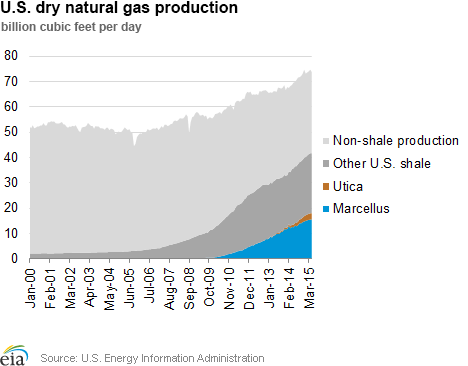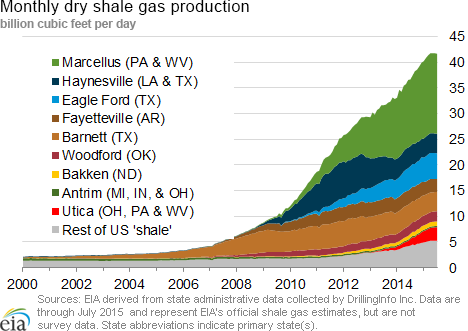In the News:
Northeast production sets record high on Monday
Production in the Northeast reached a record high of 20.4 billion cubic feet (Bcf) on Monday, August 24, according to Bentek Energy data. In the last several years, growth in total U.S. natural gas production has been driven largely by production gains in the Marcellus and Utica shale plays. Marcellus, which spans Ohio, Pennsylvania, and West Virginia, is the most productive U.S. shale play, and alone accounted for 21% of total U.S. dry natural gas production in the first five months of 2015. During that period, total U.S. dry gas production grew 8% over 2014 levels for the same period, with increases in Marcellus production contributing more than half of that growth. The record high Northeast production on Monday may be attributed to the completion of maintenance in the area.
The relatively large volumes of natural gas produced in the Northeast combined with constrained pipeline takeaway capacity have contributed to natural gas prices in that area that are below prices in other regions of the country. The price discount for prices at Transco’s Leidy line in Marcellus to the U.S. benchmark Henry Hub has averaged $1.48 per million British thermal units (MMBtu) since the start of the year. This price difference has contributed to the announcements from some producers that they will be slowing their drilling activity in the Marcellus and Utica until new pipeline takeaway capacity enters service.
In an August 5 earnings release, Chesapeake Energy, which produced approximately 2 Bcf per day (Bcf/d) of natural gas in the second quarter of 2015 from the Marcellus and Utica shale plays, announced that it is curtailing 0.8 Bcf/d of potential production in those two plays because of low prices. Similarly, during an August 17 presentation at the Oil and Gas Conference 20, Cabot Oil and Gas, whose Marcellus production has averaged 1.7 Bcf/d to 1.8 Bcf/d in 2015, announced that it anticipates a reduction in drilling and completion activity in 2015 because of low natural gas prices. Both Chesapeake and Cabot expect that their production will increase with the start of several pipeline projects that are designed to move gas out of the Northeast into other regions, including Spectra Energy’s Ohio Pipeline Energy Network project, which is planned to come online in fourth quarter 2015, and the Constitution pipeline, which is projected to come online in 2016.
EIA’s August Drilling Productivity Report (DPR), which provides near-term estimates of natural gas production across all major shale plays based on estimates of new well production and legacy well decline rates, projects natural gas production across all plays to decline in September. Several external factors, which are not accounted for in the DPR, could affect the estimates, such as bad weather, shut-ins based on environmental or economic issues, variations in the quality and frequency of state production data, and infrastructure constraints. For example, the Rockies Express Pipeline Zone 3 East-to-West Project, which came into service on August 1 and will enable the delivery of 1.8 Bcf/d of Appalachian natural gas production west on its existing mainline, may encourage increased production from regions such as the Marcellus and Utica.
Overview:
(For the Week Ending Wednesday, August 26, 2015)
- Prices of natural gas varied slightly, but were generally flat at most market locations over the report week (Wednesday, August 19, through Wednesday, August 26). The Henry Hub spot price began the week at $2.73 per million British thermal units (MMBtu) last Wednesday and ended the week at $2.72/MMBtu.
- At the New York Mercantile Exchange (Nymex), the September near-month contract began the week at $2.716/MMBtu last Wednesday and ended the week at $2.693/MMBtu yesterday. The September contract expires today, August 27, bringing the October futures contract, which opened today at $2.703/MMBtu, forward as the new prompt month contract tomorrow.
- Working natural gas in storage increased to 3,099 Bcf as of Friday, August 21. A net injection into storage of 69 Bcf for the week resulted in storage levels 18% above a year ago and 3% above the five-year average for this week.
- The total oil and natural gas rig count increased by one from the previous week with 885 units in service for the week ending Friday, August 21, according to data from Baker Hughes Incorporated. The oil rig count increased by 2 to 674 units, while the natural gas rig count was unchanged at 211 units. The count for miscellaneous rigs (for exploration, testing, and survey work) was reduced to zero. The weekly rig count is 1,011 rigs less than the total for the same week in 2014.
- The natural gas plant liquids composite price at Mont Belvieu, Texas, decreased by 3¢ per MMBtu to $4.45/MMBtu, or down 0.8% for the week ending August 21. Natural gasoline, ethane, and butane decreased by 3.9%, 2.9%, and 0.5%, respectively, while propane and isobutane rose by 2.4% and 0.4%.
Prices/Demand/Supply:
Prices vary slightly, but flat in many market locations. At the start of the report week, temperatures were generally above average in the East, South, and West, though below average in the Midwest and Rockies. Temperatures remained moderate in the central states and dropped some in most other regions, with the exception of the Northeast, which remained above average. The Henry Hub spot price began the report week at $2.73/MMBtu last Wednesday and settled yesterday down slightly at $2.72/MMBtu. Prices at other market locations also declined slightly. Spot prices at the Chicago Citygate decreased by 4¢ Wednesday-to-Wednesday, closing yesterday at $2.81/MMBtu. Prices at PG&E Citygate, serving Northern California, declined from $3.18/MMBtu last Wednesday to $3.12/MMBtu yesterday. Of note, the trading point Sumas, which is the primary border crossing for natural gas from Canada to Washington state, serving the Pacific Northwest, saw a rise from $2.07/MMBtu last Wednesday to $2.53/MMBtu yesterday because of supply constraints on the Canadian side.
Northeast prices respond to increased power burn. In the Northeast, prices fluctuated during the report week in response to varying temperatures, with New York and New England seeing above average temperatures for part of the week. New England spot prices also responded to an increased demand for natural gas because of an outage at the Pilgrim-1 nuclear power station, near Plymouth, Massachusetts, which started on Saturday, August 22, and ended yesterday. Gas prices at the Algonquin Citygate, which serves Boston, started the report week at $2.62/MMBtu, decreased to $2.35/MMBtu for the weekend, then rose on Tuesday, because of above-average temperatures and increased power sector demand, to $3.29/MMBtu, and settled at $3.06/MMBtu yesterday. Similarly, at the Tennessee Zone 6 200L serving lower New England, prices fluctuated during the report week, starting last Wednesday at $2.53/MMBtu, increasing to $3.22/MMBtu on Tuesday, and settling yesterday at $3.02/MMBtu. At Transcontinental Pipeline's Zone 6, serving New York City, the spot price started the report week at $2.73/MMBtu and ended the report week yesterday at $2.66/MMBtu.
Marcellus prices rise, but still low. While Marcellus-area prices rose through the report week by as much as 31%, they are still relatively low. At Tennessee’s Zone 4 Marcellus location, prices increased from 78¢/MMBtu last Wednesday to $1.02/MMBtu yesterday. On the Transco Leidy Line, prices started the week at 77¢/MMBtu last Wednesday and rose 24¢, to $1.01 yesterday. At Dominion South, which serves customers in portions of Pennsylvania, Ohio, Maryland, West Virginia, and Virginia, prices remained flat for most of the week, starting at $1.22/MMBtu, then fluctuating slightly to end the report week at $1.18/MMBtu.
Nymex prices decline. At the Nymex, the September contract began the week at $2.716/MMBtu and fell 2¢ to close at $2.693 /MMBtu yesterday. The October contract, which becomes the prompt month contract tomorrow, opened today at $2.703/MMBtu. The 12-month strip, which averages the September 2015 through August 2016 Nymex prices, also declined through the week to close at $2.879/MMBtu yesterday, down 5¢/MMBtu from the week-ago price.
Supply decreased slightly. Dry natural gas production increased by 0.4% this week and averaged 72.3 billion cubic feet per day (Bcf/d), 4% higher than last year’s level for the same week, according to Bentek Energy data. Imports of natural gas from Canada were down in all regions, decreasing 6% week-over-week. LNG sendout decreased by 15% over the previous week, with the effect on supply remaining marginal. Overall, total supply was down for the week by 0.2%, though it was 4% greater than the same period last year.
Consumption decreases. U.S. consumption decreased 6% for the week, led by an 11% decrease in the power sector. Consumption of natural gas for power generation (power burn) decreased in all regions, except for the Southeast, which had a 0.3% increase over the preceding week. Led by a reduction of 61% in the Midwest, total power burn was down 11% week-over-week, and down 0.8% from the same week last year. Industrial consumption declined slightly by 0.8%, and was 2% lower than the same week last year. Exports to Mexico averaged 2.9 Bcf/d, a 1.4% decrease from the previous week, but 41% higher than exports for the same week last year.
Storage
Net storage injection is higher than the five-year average, but lower than last year’s build. The net injection reported for the week ending August 21 was 69 Bcf, up from 53 Bcf the previous week. This compares with the five-year average increase of 61 Bcf for the week and last year’s increase of 77 Bcf. Working gas inventories for the storage week totaled 3,099 Bcf, 480 Bcf (18%) higher than last year at this time and 88 Bcf (3%) higher than the five-year (2010-14) average.
Storage injections are higher than market expectations. Market expectations, on average, called for a build of 61 Bcf. When the EIA storage report was released at 10:30 a.m. on August 27, the price for the September natural gas futures contract fell a few cents to around $2.65/MMBtu in Nymex futures trading. In the next hour, the price oscillated between $2.64 and $2.68/MMBtu.
From the week ending April 3 (the beginning of the injection season) through the week ending August 21, net storage injections totaled 1,638 Bcf, or 148 Bcf less than the 1,786 Bcf injected during the same 21 weeks in 2014. During these weeks for the years 2010-14, net injections into storage averaged 1,360 Bcf. The estimated average unit value of the natural gas storage holders put into storage from April 3 to August 21 this year is $2.77/MMBtu, 37% lower than the average value of $4.38/MMBtu for the same 21 weeks last year. The highest winter-month Nymex price (for the January 2016 contract) in trading for the week ending August 21 averaged $3.09/MMBtu. This price is 37¢/MMBtu more than the September Nymex contract price. A year ago, the difference was 40¢/MMBtu.
Temperatures during the storage report week were warmer than normal. Temperatures in the Lower 48 states averaged 76° for the storage report week, 2° warmer than the 30-year normal temperature and 3° warmer than the average temperature during the same week last year. There were 82 population-weighted cooling degree days (CDD) this report week, 16 CDD more than the five-year average and 22 CDD more than during this week last year.
See also:
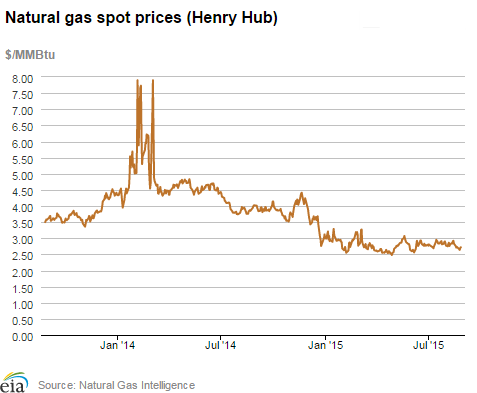
| Spot Prices ($/MMBtu) | Thu, 20-Aug |
Fri, 21-Aug |
Mon, 24-Aug |
Tue, 25-Aug |
Wed, 26-Aug |
|---|---|---|---|---|---|
| Henry Hub |
2.71 |
2.70 |
2.64 |
2.70 |
2.72 |
| New York |
2.62 |
2.78 |
2.54 |
2.55 |
2.66 |
| Chicago |
2.81 |
2.77 |
2.72 |
2.80 |
2.81 |
| Cal. Comp. Avg,* |
2.85 |
2.78 |
2.85 |
2.84 |
2.86 |
| Futures ($/MMBtu) | |||||
| September contract |
2.755 |
2.676 |
2.650 |
2.685 |
2.693 |
| October contract |
2.785 |
2.697 |
2.656 |
2.695 |
2.703 |
| *Avg. of NGI's reported prices for: Malin, PG&E citygate, and Southern California Border Avg. | |||||
| Source: NGI's Daily Gas Price Index | |||||
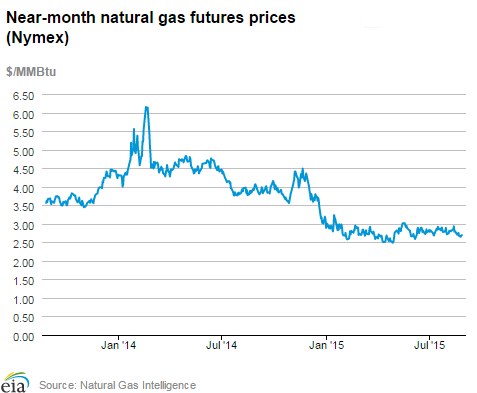
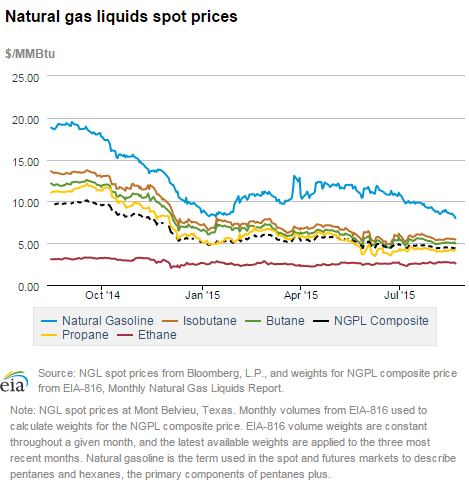
| U.S. natural gas supply - Gas Week: (8/19/15 - 8/26/15) | ||
|---|---|---|
Percent change for week compared with: |
||
last year |
last week |
|
| Gross production | 4.20%
|
0.40%
|
| Dry production | 4.20%
|
0.40%
|
| Canadian imports | 2.80%
|
-6.20%
|
| West (net) | 21.20%
|
-3.00%
|
| Midwest (net) | -21.80%
|
-9.90%
|
| Northeast (net) | -124.90%
|
-4.90%
|
| LNG imports | 129.20%
|
-15.00%
|
| Total supply | 4.30%
|
-0.20%
|
| Source: BENTEK Energy LLC | ||
| U.S. consumption - Gas Week: (8/19/15 - 8/26/15) | ||
|---|---|---|
Percent change for week compared with: |
||
last year |
last week |
|
| U.S. consumption | -0.5%
|
-5.6%
|
| Power | -0.8%
|
-11.0%
|
| Industrial | -1.8%
|
-0.8%
|
| Residential/commercial | 2.7%
|
2.1%
|
| Total demand | 0.8%
|
-5.4%
|
| Source: BENTEK Energy LLC | ||
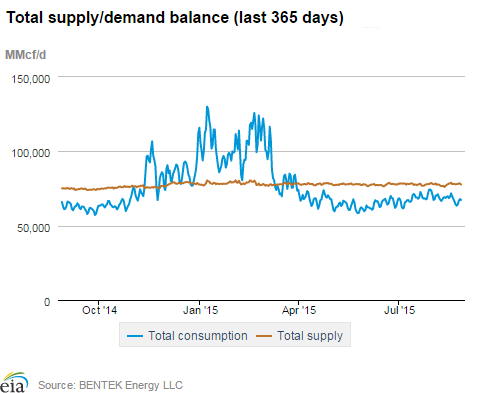
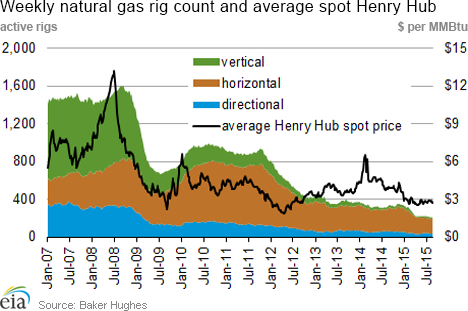
| Rigs | |||
|---|---|---|---|
Fri, August 21, 2015 |
Change from |
||
last week |
last year |
||
| Oil rigs | 674 |
0.30% |
-56.91% |
| Natural gas rigs | 211 |
0.00% |
-36.06% |
| Miscellaneous | 0 |
-100.00% |
-100.00% |
| Rig numbers by type | |||
|---|---|---|---|
Fri, August 21, 2015 |
Change from |
||
last week |
last year |
||
| Vertical | 130 |
2.36% |
-64.48% |
| Horizontal | 677 |
0.15% |
-48.75% |
| Directional | 78 |
-3.70% |
-62.68% |
| Source: Baker Hughes Inc. | |||
| Working gas in underground storage | ||||
|---|---|---|---|---|
Stocks billion cubic feet (bcf) |
||||
| Region | 2015-08-21 |
2015-08-14 |
change |
|
| East | 1,510 |
1,457 |
53 |
|
| West | 479 |
475 |
4 |
|
| Producing | 1,110 |
1,098 |
12 |
|
| Total | 3,099 |
3,030 |
69 |
|
| Source: U.S. Energy Information Administration | ||||
| Working gas in underground storage | |||||
|---|---|---|---|---|---|
Historical comparisons |
|||||
Year ago (8/21/14) |
5-year average (2010-2014) |
||||
| Region | Stocks (Bcf) |
% change |
Stocks (Bcf) |
% change |
|
| East | 1,394 |
8.3 |
1,569 |
-3.8 |
|
| West | 415 |
15.4 |
461 |
3.9 |
|
| Producing | 810 |
37.0 |
981 |
13.1 |
|
| Total | 2,619 |
18.3 |
3,011 |
2.9 |
|
| Source: U.S. Energy Information Administration | |||||
| Temperature -- heating & cooling degree days (week ending Aug 20) | ||||||||
|---|---|---|---|---|---|---|---|---|
HDD deviation from: |
CDD deviation from: |
|||||||
| Region | HDD Current |
normal |
last year |
CDD Current |
normal |
last year |
||
| New England | 0
|
-4
|
-11
|
69
|
37
|
63
|
||
| Middle Atlantic | 0
|
-3
|
-6
|
79
|
33
|
61
|
||
| E N Central | 2
|
-4
|
-9
|
62
|
18
|
33
|
||
| W N Central | 11
|
5
|
9
|
51
|
-7
|
-8
|
||
| South Atlantic | 0
|
0
|
0
|
98
|
9
|
12
|
||
| E S Central | 0
|
0
|
0
|
81
|
-4
|
3
|
||
| W S Central | 0
|
0
|
0
|
118
|
-2
|
-9
|
||
| Mountain | 6
|
-1
|
6
|
88
|
19
|
15
|
||
| Pacific | 1
|
-3
|
0
|
74
|
31
|
18
|
||
| United States | 2
|
-2
|
-2
|
82
|
15
|
22
|
||
|
Note: HDD = heating degree-day; CDD = cooling degree-day Source: National Oceanic and Atmospheric Administration | ||||||||
Average temperature (°F)
7-Day Mean ending Aug 20, 2015
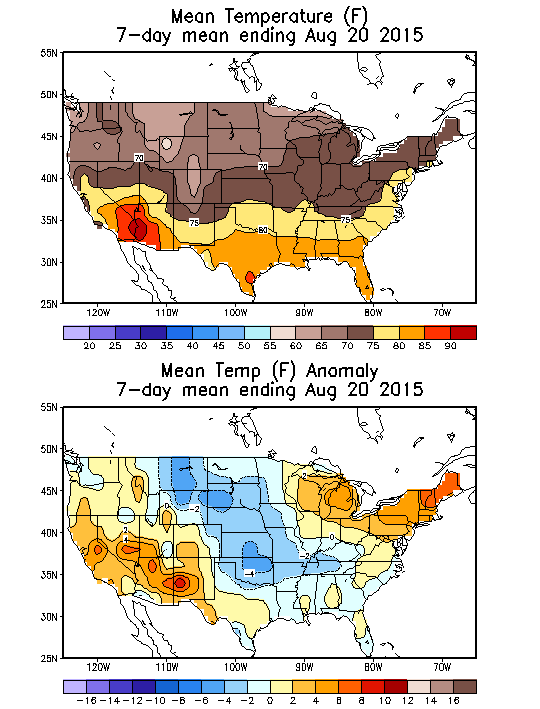
Source: NOAA/National Weather Service
Deviation between average and normal (°F)
7-Day Mean ending Aug 20, 2015

Source: NOAA/National Weather Service

